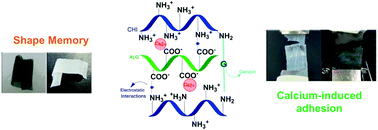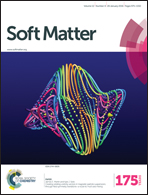Polysaccharide-based freestanding multilayered membranes exhibiting reversible switchable properties†
Abstract
The design of self-standing multilayered structures based on biopolymers has been attracting increasing interest due to their potential in the biomedical field. However, their use has been limited due to their gel-like properties. Herein, we report the combination of covalent and ionic cross-linking, using natural and non-cytotoxic cross-linkers, such as genipin and calcium chloride (CaCl2). Combining both cross-linking types the mechanical properties of the multilayers increased and the water uptake ability decreased. The ionic cross-linking of multilayered chitosan (CHI)–alginate (ALG) films led to freestanding membranes with multiple interesting properties, such as: improved mechanical strength, calcium-induced adhesion and shape memory ability. The use of CaCl2 also offered the possibility of reversibly switching all of these properties by simple immersion in a chelate solution. We attribute the switch-ability of the mechanical properties, shape memory ability and the propensity for induced-adhesion to the ionic cross-linking of the multilayers. These findings suggested the potential of the developed polysaccharide freestanding membranes in a plethora of research fields, including in biomedical and biotechnological fields.


 Please wait while we load your content...
Please wait while we load your content...